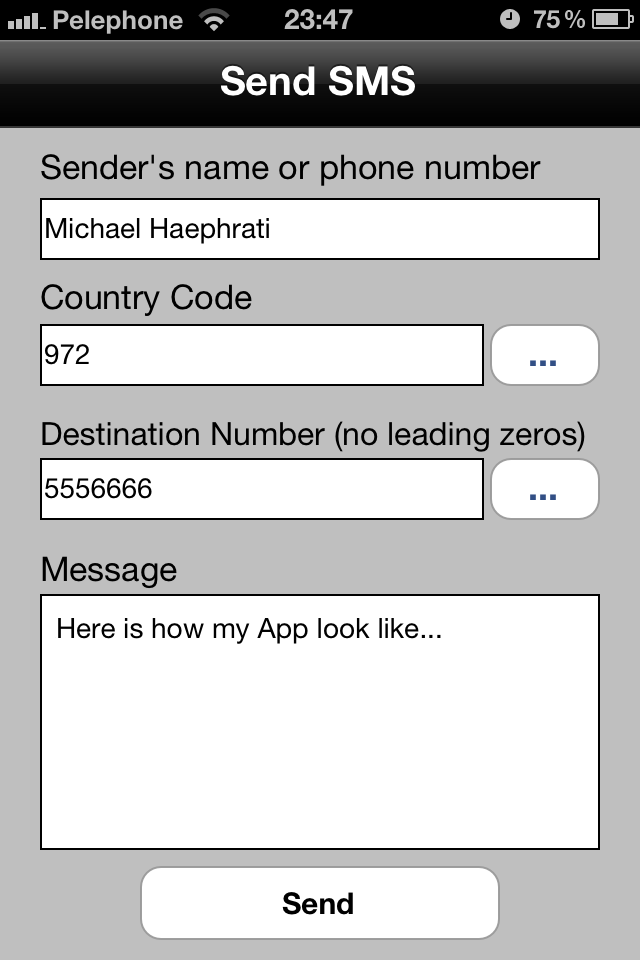This article explains how to write an iOS App that will use HTTP to send an SMS.
Background
In my article, How to send an SMS from a Desktop Application, I mentioned CardBoardFish, a simple and easy to use API for sending SMS messages world wide.
The SendSMS App
The app is very basic and simple. It has one screen which looks like this:

Basically, you enter the sender's name or number (which could be anything), the country code and phone number of the recipient and a message, and then press "Send".
The message is then sent, and a confirmation number pops up.

The most important building block of the App is the Send routine (in ViewController.m):
- (void) send {
@autoreleasepool {
NSString *url = [NSString stringWithFormat:
@"http://sms1.cardboardfish.com:9001/HTTPSMS?S=H&UN=%@&P=%@&DA=%@%@&SA=%@&M=%@&DC=4",
@"<PLACE YOUR USER NAME HERE>", @"<PLACE YOUR PASSWORD HERE", txtCountryCode.text,
txtDestinationNo.text, txtName.text,[self stringToHex:txtMessage.text]];
url = [url stringByAddingPercentEscapesUsingEncoding:NSUTF8StringEncoding];
NSLog(@"url %@", url);
NSError* connError = 0;
NSURLResponse* response;
NSURLRequest* request = [NSURLRequest requestWithURL:[NSURL URLWithString:url]
cachePolicy:NSURLRequestReloadIgnoringCacheData timeoutInterval:20];
NSData* data = [ NSURLConnection sendSynchronousRequest:
request returningResponse:&response error:&connError ];
NSString* resp = [[NSString alloc] initWithData:data encoding:NSUTF8StringEncoding];
NSLog(@"response: %@", resp);
Interfacing with the Device's Address Book
In order to easily select existing contacts from your IPhone, the openContacts routine is used, which uses a Class named ABPeoplePickerNavigationController which according to Apple, "implements a view controller that manages a set of views that allow the user to select a contact or one of its contact-information items from an address book".
- (IBAction)openContacts:(id)sender {
ABPeoplePickerNavigationController *picker =
[[ABPeoplePickerNavigationController alloc] init];
picker.peoplePickerDelegate = self;
NSArray *displayedItems = [NSArray arrayWithObjects:
[NSNumber numberWithInt:kABPersonPhoneProperty],
[NSNumber numberWithInt:kABPersonEmailProperty],
[NSNumber numberWithInt:kABPersonBirthdayProperty], nil];
picker.displayedProperties = displayedItems;
[self presentModalViewController:picker animated:YES];
[picker release];
}
After an entry from the Address Book is selected, we perform some basic cleansing on it, such as removing leading zeros and spaces, dashes and brackets. So the number "(04) 888-3333" becomes "48883333" which is the required format for the SDK.
- (BOOL)peoplePickerNavigationController:(ABPeoplePickerNavigationController *)
peoplePicker shouldContinueAfterSelectingPerson:(ABRecordRef)person
property:(ABPropertyID)property identifier:(ABMultiValueIdentifier)identifier
{
NSString* phone = nil;
ABMultiValueRef phoneNumbers = ABRecordCopyValue(person,
property);
if (ABMultiValueGetCount(phoneNumbers) > 0) {
phone = (__bridge_transfer NSString*)
ABMultiValueCopyValueAtIndex(phoneNumbers, identifier);
} else {
phone = @"[None]";
}
phone = [phone stringByReplacingOccurrencesOfString:@"(" withString:@""];
phone = [phone stringByReplacingOccurrencesOfString:@")" withString:@""];
phone = [phone stringByReplacingOccurrencesOfString:@"-" withString:@""];
phone = [phone stringByReplacingOccurrencesOfString:@" " withString:@""];
if ([[phone substringWithRange:NSMakeRange(0, 1)] isEqual:@"0"] ) {
phone = [phone substringFromIndex:1];
}
txtDestinationNo.text = phone;
[self dismissModalViewControllerAnimated:YES];
return NO;
}
Country Flags
A nice part I have added is a list of countries along with each country's flag. Not really necessary through... I used 226 flag .PNG images named as the country code of each flag, so 49.png holds the German flag, and so on...

Then CountryCodesViewController.m source file looks like this:
#import "CountryCodesViewController.h"
@interface CountryCodesViewController ()
@end
@implementation CountryCodesViewController
@synthesize mainViewController;
- (id)initWithNibName:(NSString *)nibNameOrNil bundle:(NSBundle *)nibBundleOrNil
{
self = [super initWithNibName:nibNameOrNil bundle:nibBundleOrNil];
if (self) {
}
return self;
}
- (void)viewDidLoad
{
[super viewDidLoad];
NSString *sourcePath = [[[NSBundle mainBundle] resourcePath]
stringByAppendingPathComponent:@"Flags"];
countryCodes = [[NSFileManager defaultManager]
contentsOfDirectoryAtPath:sourcePath error:NULL];
[countryCodes retain];
}
- (void)viewDidUnload
{
[tblCountryCodes release];
tblCountryCodes = nil;
[super viewDidUnload];
}
- (BOOL)shouldAutorotateToInterfaceOrientation:(UIInterfaceOrientation)interfaceOrientation
{
return (interfaceOrientation == UIInterfaceOrientationPortrait);
}
- (void)dealloc {
[tblCountryCodes release];
[super dealloc];
}
#pragma mark UITableView methods
- (NSInteger)tableView:(UITableView *)tableView numberOfRowsInSection:(NSInteger)section {
return [countryCodes count];
}
- (UITableViewCell *)tableView:(UITableView *)tableView
cellForRowAtIndexPath:(NSIndexPath *)indexPath {
UITableViewCell *cell = [[[UITableViewCell alloc]
initWithStyle:UITableViewCellStyleDefault reuseIdentifier:nil] autorelease];
NSString *strFlagName = [countryCodes objectAtIndex:indexPath.row];
cell.textLabel.text = [strFlagName substringToIndex:[strFlagName length] - 4];
cell.imageView.image =
[UIImage imageNamed:[NSString stringWithFormat:@"Flags/%@",strFlagName]];
return cell;
}
- (void)tableView:(UITableView *)tableView didSelectRowAtIndexPath:(NSIndexPath *)indexPath {
NSString *strFlagName = [countryCodes objectAtIndex:indexPath.row];
[mainViewController selectCountryCode:
[strFlagName substringToIndex:[strFlagName length] - 4]];
[tableView deselectRowAtIndexPath:indexPath animated:NO];
[self dismissModalViewControllerAnimated:YES];
}
- (IBAction)okPressed:(id)sender {
[self dismissModalViewControllerAnimated:YES];
}
@end
Error Handling
When an error occurs, an error code appears indicating the nature of the error. The HTTPSMS SDK documentation explains each error number.

There can be several scenarios in which the transmission fails.
The first one is Connectivity Error. Such error can occur if the IPhone is not connected to the Internet. In such case, we would like to alert the user, and yet, place the SMS in a queue to be sent when the IPhone connects to the Internet. We also would like that in case several SMS messages were composed during the time the device was offline, they will all be placed in the queue and transmitted whenever possible.
This example does not perform any logical error checks (such as validating the format of the phone number, country code, etc. and in any case, only after a message is sent to the Web Service, there might be additional error codes that will raise.
if ( connError ) {
NSLog(@"%@",[connError description]);
NSMutableDictionary *message = [[NSMutableDictionary alloc] init];
[message setValue:txtCountryCode.text forKey:@"countryCode"];
[message setValue:txtDestinationNo.text forKey:@"destinationNo"];
[message setValue:txtName.text forKey:@"name"];
[message setValue:txtMessage.text forKey:@"message"];
[self performSelectorOnMainThread:@selector(addToQueue:)
withObject:message waitUntilDone:NO];
[message release];
UIAlertView* alert = [[UIAlertView alloc] init];
alert.title = @"Send SMS";
alert.message = @"Can't access Internet.
The message will be queued to be sent later";
[alert addButtonWithTitle:@"Ok"];
[alert show];
[alert release];
} else {
UIAlertView* alert = [[UIAlertView alloc] init];
alert.title = @"Send SMS";
alert.message = resp;
[alert addButtonWithTitle:@"Ok"];
[alert show];
[alert release];
if ([resp rangeOfString:@"OK"].location != NSNotFound) {
[self performSelectorOnMainThread:@selector(sendComplete)
withObject:nil waitUntilDone:YES];
}
}
[resp release];
}
loadingView.hidden = YES;
}
Further Reading
Points of Interest
If you need help getting started with iOS development, please read this article.
Michael Haephrati , CodeProject MVP 2013
History
- 16th February, 2013: Initial version
